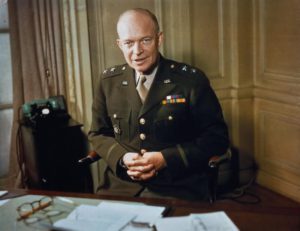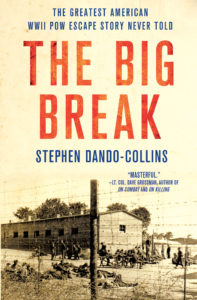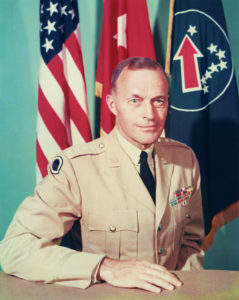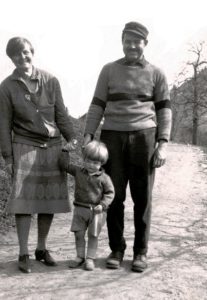by Stephen Dando-Collins
Eisenhower’s aide, Patton’s son-in-law, Hemingway’s son: The Greatest POW Escape in American History
Tall, thin Lieutenant Craig D. Campbell, from Austin, Texas was among the first Americans to arrive at the Nazi’s Oflag 64 POW camp at Schubin, Poland in June, 1943. Twenty-six year-old Campbell harbored a secret: since 1941, he’d been aide-de-camp to General Dwight D. Eisenhower, then American supreme commander in North Africa.

Campbell is attacked by the Nazi Afrika Corps
For months, Campbell had pestered Eisenhower for an opportunity to see the war first hand. That March, Eisenhower had agreed, leaving him with the 9th Infantry Division, then in reserve in Tunisia, for a four week posting. It was a case of being careful of what you wish for. Before long, the Axis’s Afrika Corps launched an unexpected attack, and the unit to which Campbell was attached, the 2nd Battalion, 47th Infantry, was thrown into action at Hill 369, near El Guettar.
Raked by artillery fire, the unit suffered heavy casualties, and Campbell and Lieutenant Sid Thal took over a foxhole to provide covering fire as the battalion attempted to withdraw. Eventually out of ammunition and water, Campbell and Thal joined seven other officers and 205 enlisted men from the battalion taken prisoner that night.
Eisenhower is devastated by Campbell’s Capture
After his capture, Campbell maintained the sham that he was just another know-nothing junior officer, fearing that if the Nazis discovered his real role they would torture him for information. General Eisenhower, meanwhile, was devastated when he learned that Campbell was missing in action. He wrote to Campbell’s parents, “Craig was not only my personal ADC, but my favorite young man in these forces.”

Campbell would have been a celebrity among his fellow prisoners had his secret become known. There was already one celebrity in the Schubin camp. Lieutenant Colonel John Knight Waters, American executive officer at Oflag 64, was the son-in-law of General George S. Patton, having married Patton’s daughter Beatrice in 1934. The handsome Johnny Waters, a 1931 West Point graduate, was forced to surrender while commanding an armored group during the same disastrous series of battles that had seen Campbell and numerous other Schubin inmates snared by the Wehrmacht.
Thirty-six-year-old Waters, a calm, composed man with a tight smile, enforced a strict adherence to military discipline in POW camp, including daily shaves and uniform inspections. This irked some American prisoners, but was essential to maintaining morale. According to Waters’ son George, “He believed, as Patton did, that if you took good care of your men, they will take care of you.”
Hemingway’s son becomes involved
The third member of this escape tale trio was a handsome, fair-haired lieutenant, John Hadley Nicanor ‘Jack’ Hemingway, eldest son of famed novelist Ernest Hemingway. The life of Jack Hemingway had been colorful right from the start. His second middle name came from a Spanish matador admired by his dad. His godparents were author Gertrude Stein and her lover Alice B. Toklas. Born in Canada, Jack had grown up in Paris and the Austrian Alps.
Enlisting in the US Army in 1943, Jack became a second lieutenant in the Military Police. Before long, pulling strings by using his name and connections, Jack was transferred to the Office of Strategic Services or OSS, forerunner of the CIA. Of 4,000 OSS candidates, only fifty, including young Hemingway, were chosen for active service. Jack’s time in Europe prior to the war, and the fact he spoke fluent French, made him an ideal spy.

Jack had undertaken several secret missions in German-occupied France before the mission in late October, 1944, just days after his twenty-first birthday, that resulted in his capture. Attached to the 3rd Infantry Division in the Vosges Mountains of Alsace-Lorraine, he guided OSS Captain Justin Greene on a mission to infiltrate a French ‘Joe,’ or civilian secret agent, behind enemy lines. Passing through heavy forest, the trio was spotted by a German alpine unit. In the following firefight, the Joe was killed, Greene took a bullet in the foot, and Jack was hit in the right arm. A submachine gun spray from the German squad sent to mop up subsequently caught Hemingway in the shoulder.
Hemingway and Greene were captured and evacuated to a hospital in Stuttgart. There, German doctors wanted to amputate Jack’s arm. Although he was a prisoner, Hemingway was able to exercise freedom of will in this one thing, refusing to let them take his arm. As an alternative, he downed sulfonamide anti-bacterial tablets and gallons of water, which he credited with saving his arm. In the first days of 1945, Hemingway and Greene were sent to POW camp. Just as Craig Campbell had revealed nothing about his link with Eisenhower, the OSS agents kept their covert role a secret, even from fellow prisoners.

The prisoners prepare for the greatest POW escape in American history
In late January, as the Germans began force-marching 300,000 Allied POWs west, away from the advancing Soviet Army, many among the 1500 American officers at Oflag 64 prepared to make a break. In the end, 250 would succeed in escaping into the hands of the Russians and reach home. Their escape stories would remain largely unknown because US Military Intelligence prevented them from talking; the Russians, who treated the Americans almost as badly as the Germans, were then our allies, and the US Government didn’t want to offend the Soviets at a delicate time in Allied relations.
Only now, in The Big Break, which is being described as ‘masterful,’ ‘engrossing’ and ‘exciting’ by reviewers, has the full story of the successful American escapes, and the fate of the remaining US officers from the Schubin camp, been chronicled. Craig Campbell, Johnny Waters and Jack Hemingway had differing experiences during this period. One briefly tasted freedom, only to be recaptured by the Germans. One stayed with the bulk of American prisoners to help his buddies, only to be shot and seriously wounded by a German soldier. The third was one of the 250 Americans who succeeded in making their escape.
To learn more about the greatest POW escape in American history, read The Big Break: The Greatest American WWII POW Escape Story Never Told by Stephen Dando-Collins, published in thr USA and Canada on January 10 and in the UK and Australia on February 13.
STEPHEN DANDO-COLLINS is an award-winning military historian and biographer with numerous highly praised books ranging from imperial Rome to World War II to the American West including Legions of Rome, Operation Chowhound, and Tycoon’s War. His books appear in many languages in many countries including the United States, Canada, the United Kingdom, Australia, New Zealand, Brazil, Italy, Spain, Portugal, Poland, Albania, Russia and Korea.
